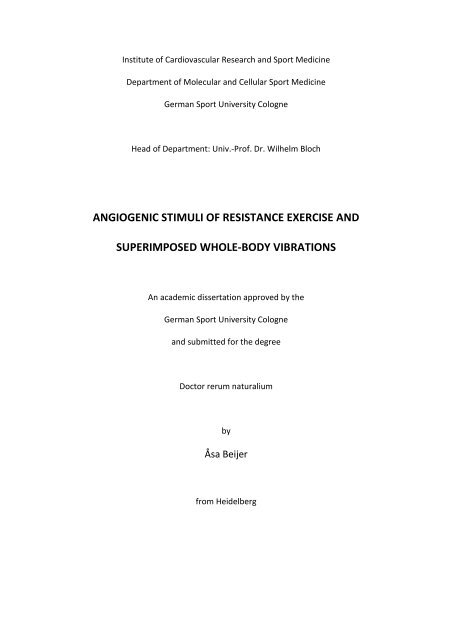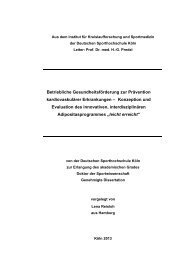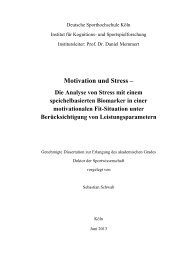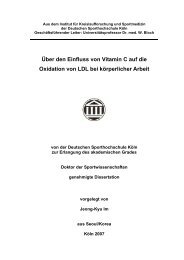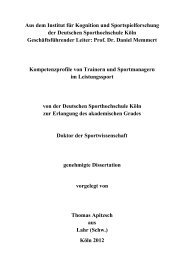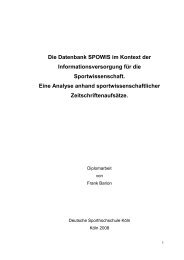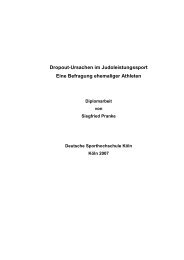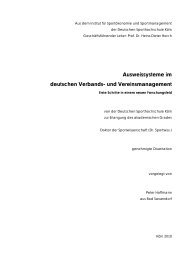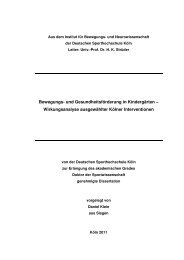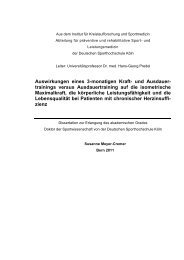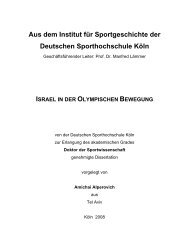angiogenic stimuli of resistance exercise and superimposed ... - eSport
angiogenic stimuli of resistance exercise and superimposed ... - eSport
angiogenic stimuli of resistance exercise and superimposed ... - eSport
Sie wollen auch ein ePaper? Erhöhen Sie die Reichweite Ihrer Titel.
YUMPU macht aus Druck-PDFs automatisch weboptimierte ePaper, die Google liebt.
Institute <strong>of</strong> Cardiovascular Research <strong>and</strong> Sport Medicine<br />
Department <strong>of</strong> Molecular <strong>and</strong> Cellular Sport Medicine<br />
German Sport University Cologne<br />
Head <strong>of</strong> Department: Univ.-Pr<strong>of</strong>. Dr. Wilhelm Bloch<br />
ANGIOGENIC STIMULI OF RESISTANCE EXERCISE AND<br />
SUPERIMPOSED WHOLE-BODY VIBRATIONS<br />
An academic dissertation approved by the<br />
German Sport University Cologne<br />
<strong>and</strong> submitted for the degree<br />
Doctor rerum naturalium<br />
by<br />
Åsa Beijer<br />
from Heidelberg
Abstract / Zusammenfassung (English)<br />
OBJECTIVES: Whole-body vibration (WBV) training has become a popular training mode in<br />
the past few years <strong>and</strong> is nowadays applied in various fields like sports, rehabilitation <strong>and</strong><br />
preventive medicine. WBV training has been shown to improve peripheral perfusion <strong>and</strong><br />
may elicit muscle deoxygenation. We hypothesized that the superposition <strong>of</strong> WBV to<br />
<strong>resistance</strong> <strong>exercise</strong> would add a pro-<strong>angiogenic</strong> stimulus to the training <strong>and</strong> we aimed to find<br />
a novel training mode that concurrently induces muscle hypertrophy <strong>and</strong> capillary growth in<br />
order to improve muscle performance. METHODS: A six-week training study including 26<br />
healthy males was conducted in a r<strong>and</strong>omized two-group parallel design, in which one group<br />
performed <strong>resistance</strong> <strong>exercise</strong> (RE) <strong>and</strong> the other group <strong>resistance</strong> <strong>exercise</strong> with<br />
<strong>superimposed</strong> whole-body vibrations (RVE). Subjects trained 2-3 times per week, concluding<br />
16 training sessions. The training consisted <strong>of</strong> squatting <strong>exercise</strong> <strong>and</strong> calf raises performed<br />
with heavy loads that were set at 80% <strong>of</strong> the one-repetition maximum. During the initial <strong>and</strong><br />
final <strong>exercise</strong> sessions <strong>of</strong> the 6-week intervention, measurements were performed at rest,<br />
during <strong>and</strong> acutely after <strong>exercise</strong>. Blood volume <strong>and</strong> tissue oxygenation were determined in<br />
gastrocnemius via near infrared spectroscopy. Angiogenic markers (matrix<br />
metalloproteinase -2 <strong>and</strong> -9, vascular endothelial growth factor (VEGF) <strong>and</strong> endostatin) were<br />
measured in serum via ELISA <strong>and</strong> the proliferative effect upon human umbilical vein<br />
endothelial cells was determined in vitro. Finally, long-term effects <strong>of</strong> the trainings on<br />
muscle morphology were determined in soleus biopsies. RESULTS: Our data are to our<br />
knowledge the first to describe transient increases <strong>of</strong> circulating <strong>angiogenic</strong> markers after<br />
<strong>resistance</strong> <strong>exercise</strong>. VEGF levels were acutely higher in the RE group, which supposedly<br />
provoked increased proliferation <strong>of</strong> endothelial cells in vitro. Furthermore, acute increases in<br />
circulating endostatin were higher in the RE group after the six-week training intervention.<br />
These effects were elusive in the RVE group. Despite differences in acute VEGF levels,<br />
capillary growth in soleus muscle was not different between groups. However, total blood<br />
volume <strong>and</strong> <strong>exercise</strong> hyperemia was increased after six weeks <strong>of</strong> RVE training.<br />
CONCLUSIONS: Our data indicate the pro-<strong>angiogenic</strong> stimulus <strong>of</strong> RE is not increased by<br />
superimposing WBV to the training. While structural adaptations in muscle tissue were<br />
similar in both groups, regular RVE training seems to influence the functional state <strong>of</strong> small<br />
arterioles <strong>and</strong> potentially capillaries, enhancing muscle perfusion <strong>and</strong> post-<strong>exercise</strong><br />
hyperemia.
Abstract / Zusammenfassung (Deutsch)<br />
Hintergrund: Ganzkörper-Vibrationstraining (‚Whole-Body Vibration‘, WBV) ist in den letzten<br />
Jahren zu einer beliebten Trainingsmethode geworden und findet heutzutage in vielen<br />
Bereichen Anwendung, z.B. in Fitnessstudios oder in der Rehabilitations-und<br />
Präventionsmedizin. Bisherige Studien zeigen, dass WBV u.a. einen positiven Effekt auf die<br />
Durchblutung hat und eine Deoxygenierung der vibrierten Muskeln herbeiführen kann. Die<br />
dieser Arbeit zu Grunde liegende Hypothese ist, dass Ganzkörpervibrationen in Kombination<br />
mit konventionellem Widerst<strong>and</strong>straining einen zusätzlichen angiogenen Stimulus erzeugen.<br />
Ziel war es, eine neue Trainingsmethode zu entwickeln und wissenschaftlich zu überprüfen,<br />
die gleichzeitig Hypertrophie und Kapillarwachstum im Muskel induziert und dadurch<br />
Muskelleistung im Sinne von Maximalkraft und Ermüdungswiderst<strong>and</strong>sfähigkeit verbessert.<br />
Methoden: Eine sechswöchige Trainingsstudie mit 26 gesunden Männern wurde im Parallel-<br />
Design durchgeführt. Eine Gruppe trainierte mit konventionellem Widerst<strong>and</strong>straining<br />
(‚resistive <strong>exercise</strong>‘: RE), während die <strong>and</strong>ere Gruppe ein Widerst<strong>and</strong>straining kombiniert mit<br />
Ganzkörpervibrationen (‚resistive vibration <strong>exercise</strong>‘: RVE) absolvierte. Die Prob<strong>and</strong>en<br />
trainierten 2-3 Mal pro Woche. Das Training best<strong>and</strong> aus Kniebeugen und Zehenständen,<br />
welche mit hohen Zusatzgewichten durchgeführt wurden (80% des One-Repetition<br />
Maximums). Funktionelle Messungen wurden während des ersten und letzten Trainings der<br />
sechswöchigen Intervention durchgeführt: jeweils vor, während und direkt nach dem<br />
Training. Muskeldurchblutung und Oxygenierung im Gastrocnemius Muskel wurden mit Nah-<br />
Infrarot Spektroskopie gemessen. Desweiteren wurden die Angiogenesemarker Matrix<br />
Metalloproteinase -2 <strong>and</strong> -9, Vascular Endothelial Growth Factor (VEGF) und Endostatin im<br />
Serum via ELISA gemessen und deren Effekt auf Endothelzellen (human umbilical vein<br />
endothelial cells) wurde in vitro bestimmt. Außerdem wurden Langzeit-Anpassungseffekte<br />
auf die Morphologie des Soleus Muskels bestimmt.<br />
Ergebnisse: Nach dem Widerst<strong>and</strong>straining konnten wir eine Erhöhung der gemessenen<br />
Angiogenesemarker im Serum feststellen. VEGF-Konzentrationen und Endothelzellen-<br />
Proliferation waren in der RE Gruppe höher im Vergleich zur der RVE Gruppe. Außerdem<br />
wurde nach der 6-wöchigen Trainingsintervention in der RE Gruppe eine erhöhte Endostatin-<br />
Konzentration direkt nach dem letzten Training gemessen, während solch ein Effekt in der<br />
RVE Gruppe ausblieb. Morphologische Daten zeigen, dass die strukturellen
Muskelanpassungen zwischen beiden Gruppen vergleichbar waren, obwohl sich die<br />
funktionelle Muskeldurchblutung der RVE Gruppe erhöhte.<br />
Schlussfolgerungen: Die Daten zeigen, dass der Zusatz von Ganzkörpervibrationen zu<br />
konventionellem Widerst<strong>and</strong>straining den pro-angiogenen Stimulus des Trainings nicht<br />
erhöht. Es wurde gezeigt, dass zwischen den beiden Gruppen strukturelle<br />
Muskelanpassungen vergleichbar sind. Dennoch scheinen Ganzkörpervibration, wenn sie in<br />
Kombination mit Widerst<strong>and</strong>straining appliziert werden, die Dilatationsfähigkeit von<br />
Arteriolen und eventuell auch von Kapillaren zu beeinflussen was sich in der erhöhten<br />
funktionellen Muskeldurchblutung widerspiegelt.


